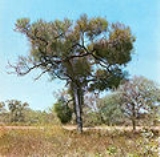
Prosopis kuntzei
Encyclopedia
Prosopis kuntzei is a South America
n leguminous tree species that inhabits the westernmost Gran Chaco
forests covering areas of Argentina
, Bolivia
, and Paraguay
, where it acts as natural component. It has also been able to colonize the nearby pasture sabanas. It's commonly referred to as itín, palo mataco, carandá or barba de tigre. It is adapted to arid climate, but can also survive flooded ground for a long time.
consists of lonely appearing raceme
s 3–7 cm long. Flowers are white-yellowish, scented, and 3 mm long. The fruit is a dehiscent
dark violet pod, 10–17 cm long, straight shaped and heavily scented. It contains a starchy paste inside. Seeds are flat, egg-shaped of chestnut colour. They measure 7-1 0 mm long and 5–6 mm wide. Wide new sprouts come out between July and November.
This tree flowers between September and November and fructifies
between December and January, holding its fruits until early August.
The sapwood is light yellow, while the heartwood is chestnut brown with patches of dark violet. The wood has a fine texture and straight to wavy to interlocked grain. When first chopped it is very scented. This species wood is one of the densest and notably most durable of the genus.
.
South America
South America is a continent situated in the Western Hemisphere, mostly in the Southern Hemisphere, with a relatively small portion in the Northern Hemisphere. The continent is also considered a subcontinent of the Americas. It is bordered on the west by the Pacific Ocean and on the north and east...
n leguminous tree species that inhabits the westernmost Gran Chaco
Gran Chaco
The Gran Chaco is a sparsely populated, hot and semi-arid lowland region of the Río de la Plata basin, divided among eastern Bolivia, Paraguay, northern Argentina and a portion of the Brazilian states of Mato Grosso and Mato Grosso do Sul, where it is connected with the Pantanal region...
forests covering areas of Argentina
Argentina
Argentina , officially the Argentine Republic , is the second largest country in South America by land area, after Brazil. It is constituted as a federation of 23 provinces and an autonomous city, Buenos Aires...
, Bolivia
Bolivia
Bolivia officially known as Plurinational State of Bolivia , is a landlocked country in central South America. It is the poorest country in South America...
, and Paraguay
Paraguay
Paraguay , officially the Republic of Paraguay , is a landlocked country in South America. It is bordered by Argentina to the south and southwest, Brazil to the east and northeast, and Bolivia to the northwest. Paraguay lies on both banks of the Paraguay River, which runs through the center of the...
, where it acts as natural component. It has also been able to colonize the nearby pasture sabanas. It's commonly referred to as itín, palo mataco, carandá or barba de tigre. It is adapted to arid climate, but can also survive flooded ground for a long time.
Morphology
It is a smooth horrid tree, 4 to 10 meters high. Its trunk measures 40 to 60 cm in diameter and is highly branched and rigid, presenting uncountable spines. Leaves are small (3–5 mm long), bipinnate, tending to fall very early in spring after young sprouts become spines themselves. InflorescenceInflorescence
An inflorescence is a group or cluster of flowers arranged on a stem that is composed of a main branch or a complicated arrangement of branches. Strictly, it is the part of the shoot of seed plants where flowers are formed and which is accordingly modified...
consists of lonely appearing raceme
Raceme
A raceme is a type of inflorescence that is unbranched and indeterminate and bears pedicellate flowers — flowers having short floral stalks called pedicels — along the axis. In botany, axis means a shoot, in this case one bearing the flowers. In a raceme, the oldest flowers are borne...
s 3–7 cm long. Flowers are white-yellowish, scented, and 3 mm long. The fruit is a dehiscent
Dehiscence (botany)
Dehiscence is the opening, at maturity, in a pre-defined way, of a plant structure, such as a fruit, anther, or sporangium, to release its contents. Sometimes this involves the complete detachment of a part. Structures that open in this way are said to be dehiscent...
dark violet pod, 10–17 cm long, straight shaped and heavily scented. It contains a starchy paste inside. Seeds are flat, egg-shaped of chestnut colour. They measure 7-1 0 mm long and 5–6 mm wide. Wide new sprouts come out between July and November.
This tree flowers between September and November and fructifies
Fructification
Fructification is a term used in the plant morphology to denote the generative parts of the plant...
between December and January, holding its fruits until early August.
The sapwood is light yellow, while the heartwood is chestnut brown with patches of dark violet. The wood has a fine texture and straight to wavy to interlocked grain. When first chopped it is very scented. This species wood is one of the densest and notably most durable of the genus.
Usage
Because of its technological wood properties, Prosopis kuntzei is considered an important Mimosaceae species. However timber is available in small sizes and limited amounts, therefore it's used rather locally to manufacture crafts like statues, handles, wooden wheel parts, musical instruments and staffs. Due to its almost black colour, and remarkable hardness, it can be used as substitute of ebonyEbony
Ebony is a dense black wood, most commonly yielded by several species in the genus Diospyros, but ebony may also refer to other heavy, black woods from unrelated species. Ebony is dense enough to sink in water. Its fine texture, and very smooth finish when polished, make it valuable as an...
.

